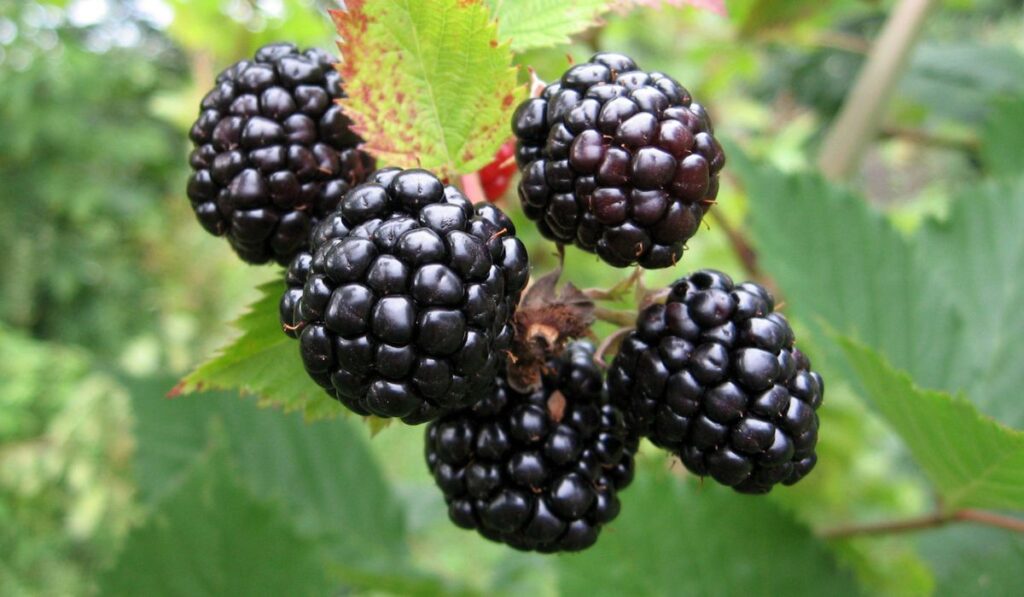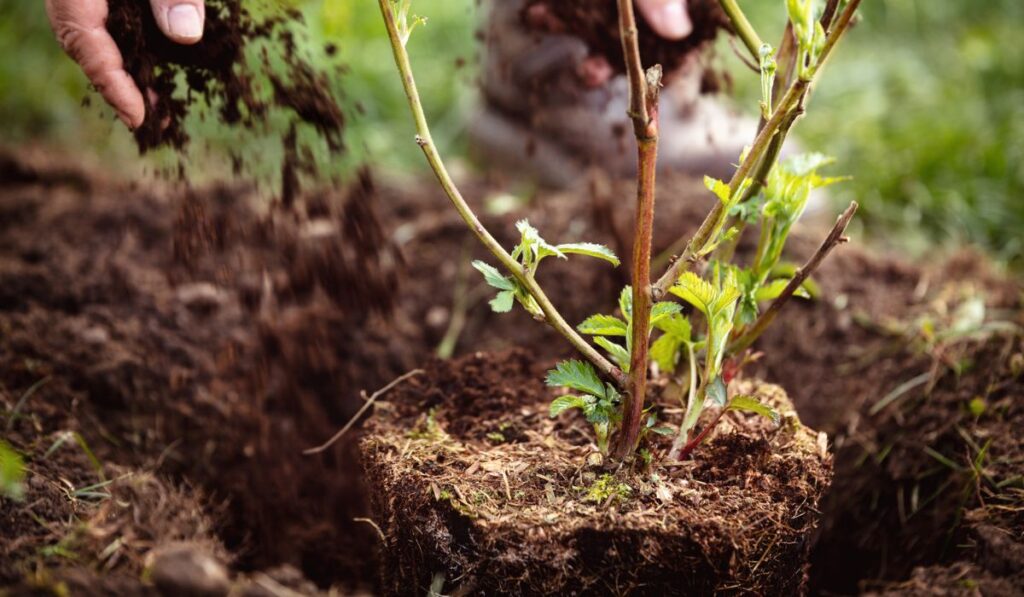Nothing can compare to the taste and freshness of homegrown fruit; however, not everyone has the space to grow a melon vine or a fruit tree. That’s why berries are the go-to option for many gardeners, as no fruit is easier to grow than blackberries. They need very little extra maintenance making it easier to grow scrumptious berries.
The best time to plant blackberries is in early spring. Make sure they get plenty of sunshine and that the soil is well-draining. Keeping the berry plant hydrated is vital for a good harvest, especially during bloom time. Plant semi-erect berries next to fences and walls to provide a trellis.
Imagine having a delicious blackberry whenever you walk out the back door or into your garage. Let’s look at how you can grow plump and juicy blackberries for all your pies, smoothies, and jams. We’ll also look at the different types of blackberries and how you can take better care of your berries.
What is the Best Time of Year to Plant Blackberries?

Blackberries are typically sold as potted plants or bare roots.
It’s best to plant them in the early spring when the canes are dormant. However, plant them in the fall if you want to grow them from seeds. Blackberry canes planted from seeds start producing abundant fruit roughly after two years.
What are the Different Types of Blackberries?
All blackberries are perennials, and their roots survive for years; however, the part above the soil is biennial. This means blackberry canes grow vegetatively for a year and give fruit the following year before dying.
However, every year new canes grow to replace the dying ones. Pruning helps to avoid a messy plant and enjoy an excellent fruit harvest.
The three different types of blackberries include:
Erect Thorny Blackberries
These blackberries grow upright and don’t need any support for the canes. Instead, these short, stiff canes grow from the root suckering and the crown (often forming a hedgerow).
Summer pruning helps the erect blackberries to grow better. Once the new primocanes are four feet tall, you should cut off one or two inches from the top. This will cause the canes to branch and increase next year’s yield.
You should regularly remove the primocanes that grow outside the hedgerow. In addition, remove the dead floricanes from the hedgerow during winter and keep the lateral branches about 1½ to 2½ feet high.
Primocane-Fruiting Erect Blackberries
In winter, cutting off the canes of primocane-fruiting erect blackberries ensures the best fruit. You should remove the top 6 inches of the primocanes in the summer when they reach 3½ feet.
Consequently, the primocanes will branch and produce a much larger yield in the fall.
Semi-Erect Blackberries
It’s easier to manage semi-erect blackberries on a Double T Trellis, and pruning of these berries should be done in the summer.
Cut off the top two inches of the primocanes once they are about 5 feet tall to boost branching. Then, clear away the dead floricanes in the winter and spread the primocanes out along the trellis.
Triple Crown and Chester are semi-erect thornless varieties that grow as a clump and can benefit significantly from a trellis.
Erect Thornless Blackberries
These blackberries are similar to thorny blackberries, but their canes don’t have prickly thorns. So they, too, don’t need any trellis support. ‘Natchez’ is the most common erect thornless blackberry.
Trailing Thornless Blackberries
These blackberries have sprawling canes that need a system of wires or trellis for support. You can opt for a two-wire system with the top wire running at five to six feet and the second line 18 inches below it. You’ll see fruiting floricanes along these wires after the first year.
Pruning the trailing blackberries after the fruit harvest period allows you to remove the old canes and let new canes take their place.
However, it’s best not to remove the old fruiting canes until they’ve died back considerably so the dying canes can move the nutrients back into the roots and crown. After removing the old fruiting canes, train the primocanes to grow up on the wire.
In areas where the winter temperature is low, it’s better to leave the primocanes on the ground during winter to provide mulch for winter protection.
Once the season changes to spring, train the old primocanes up on the wires. Avoid working with the canes during winter as there’s more chance of breaking.
How to Choose a Planting Location
Blackberries belong to the Rosaceae family, which is why their cultivation resembles that of rose bushes. Fortunately, compared to roses, blackberries are easier to take care of.
Although blackberries can survive many growing conditions, the harvest of a blackberry plant facing unfavorable conditions would be pretty lacking compared to the yield of a plant growing in favorable conditions.
- For juicy, sweet, and jumbo blackberries, it’s essential to provide the plant with regular irrigation, rich loamy soil, and plenty of sunshine.
- When planting blackberries, ensure the plants are spaced 5 to 6 feet apart, while spacing in rows should be 5 to 6 feet apart. Amending the soil, if necessary, before planting makes it rich, well-drained, and slightly acidic.
- As blackberries like to spread, selecting a location that naturally limits their growth is best. Installing the trailing varieties next to buildings and fences is best as it provides trellising.
- When planting blackberries, dig a wide, shallow hole that can hold all the roots. Trim off any damaged or dead root tissue before spreading the roots within the hole.
- Blackberry roots shouldn’t be planted in a hole more than 2 inches deep. Eliminate any air pockets by pressing the soil firmly after covering the hole. Water generously to hydrate the canes and settle the soil.
Care Tips for Healthy Blackberries

Make sure you follow the care instructions given below to grow healthy blackberries:
Soil
Choose the planting site of your blackberries carefully to ensure their long life. With proper care, these plants can live for almost a decade. Slightly acidic soil with good drainage is ideal for blackberries; however, these plants don’t do well in clay soil.
Growing these plants in raised beds or on an elevated site helps drainage and protects the flower buds from damage due to late spring frosts. Remove all weeds, as they might draw away the water and nutrients from the blackberries.
Keeping a layer of mulch over the roots always helps conserve moisture, feed the plants, and keep the weeds down.
Light
Areas that get plenty of sunlight are best for blackberries. However, some afternoon shade is also tolerated in places with hot summers.
Water
Wet soil or standing water isn’t healthy for blackberries. They need moderate amounts of water, about an inch per week, provided by ground-level irrigation or rainfall. However, frequent watering is essential during the blooming period.
Water stress and too much heat at bloom time can cause a ‘berry blast’—a condition where the entire season’s crop is lost. Investing in drip irrigation or soaker hoses is best for blackberries as they keep the berry plants hydrated and healthy without wasting water.
Fertilizer
The best time to fertilize your berry plants is in spring, when the plants start emerging from dormancy.
Then, use a balanced 10-10-10 formula and fertilize the plants again with compost and manure during fall. This will help improve soil tilth and suppress weeds.
Temperature and Humidity
Blackberries need a cold dormancy period to germinate, but they don’t do well in places where the temperature drops below zero constantly due to their shallow root system.
The warm environment of hardiness zones 5 to 8 is best for blackberries. Wet spring soils and cold winter temperatures can cause the plants to die. Hot, dry winds are also not favorable for growing blackberries as they can result in seedy, stunted yields.
